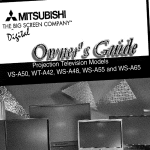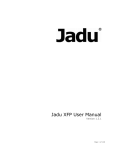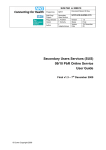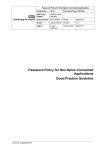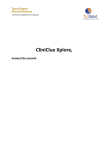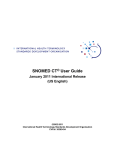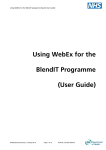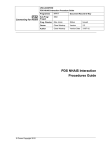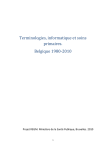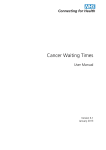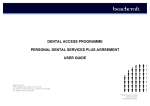Download SNOMED CT® A user guide for General Practice
Transcript
SNOMED CT® A user guide for General Practice © Crown Copyright 2012 UK Terminology Centre: www.nhscfh.nhs.uk/uktc 1 Contents Purpose of this guide ........................................................................................................................ 4 Introduction ...................................................................................................................................... 4 What is SNOMED CT? ....................................................................................................................... 5 Why Use SNOMED CT? ..................................................................................................................... 5 Benefits of Using SNOMED CT .......................................................................................................... 6 Who develops and supports SNOMED CT? ...................................................................................... 7 New SNOMED CT requests and updates .......................................................................................... 7 SNOMED CT releases .................................................................................................................... 8 How is SNOMED CT Structured? ...................................................................................................... 8 Concepts ....................................................................................................................................... 8 Relationships ................................................................................................................................ 9 Subsets ......................................................................................................................................... 9 Using SNOMED CT – some fundamentals ...................................................................................... 11 Recording in SNOMED CT ........................................................................................................... 11 Searching SNOMED CT ............................................................................................................... 11 Reporting from SNOMED CT coded items .................................................................................. 12 Selecting specific SNOMED CT terms ......................................................................................... 13 Combination of using relationships and specifying terms ......................................................... 13 Abbreviations and acronyms ...................................................................................................... 14 Concepts that should NOT be used in clinical records ............................................................... 14 SNOMED CT hierarchies ............................................................................................................. 15 Data translation .............................................................................................................................. 15 Support ........................................................................................................................................... 16 Training ........................................................................................................................................... 16 Produced by the UK Terminology Centre, Department of Health Informatics Directorate ............ 16 Version 1, April 2012 ...................................................................................................................... 16 Appendix 1 – SNOMED CT Glossary ............................................................................................... 17 ATTRIBUTE .................................................................................................................................. 17 BROWSER ................................................................................................................................... 17 CLASSIFICATION .......................................................................................................................... 17 CONCEPT..................................................................................................................................... 17 CONCEPTID ................................................................................................................................. 17 CROSS MAP................................................................................................................................. 17 CTV3............................................................................................................................................ 17 CTV3ID ........................................................................................................................................ 17 DEFAULT CONTEXT ..................................................................................................................... 18 DESCRIPTION .............................................................................................................................. 18 © Crown Copyright 2012 UK Terminology Centre: www.nhscfh.nhs.uk/uktc 2 DESCRIPTIONID ........................................................................................................................... 18 FULLY SPECIFIED NAME (FSN) .................................................................................................... 18 HIERARCHY ................................................................................................................................. 18 INTERNATIONAL EDITION ........................................................................................................... 18 INTERNATIONAL RELEASE........................................................................................................... 18 PREFERRED TERM ....................................................................................................................... 19 QUALIFIER ................................................................................................................................... 19 READ v2 ...................................................................................................................................... 19 RELATIONSHIP ............................................................................................................................ 19 SUBSET........................................................................................................................................ 19 SYNONYM ................................................................................................................................... 19 TERM .......................................................................................................................................... 19 TERMID ....................................................................................................................................... 19 TERMINOLOGY ........................................................................................................................... 20 TOP LEVEL CONCEPT................................................................................................................... 20 UK EDITION ................................................................................................................................. 20 UK RELEASE................................................................................................................................. 20 Appendix 2 ...................................................................................................................................... 21 SNOMED CT hierarchies ............................................................................................................. 21 a) Regularly used in clinical records without further elaboration:......................................... 21 b) Used in clinical records, but usually require additional context: ....................................... 22 c) Used in clinical records to provide context to other terms: ............................................... 23 d) May be in historical records but not recommended for clinical data entry: ..................... 23 © Crown Copyright 2012 UK Terminology Centre: www.nhscfh.nhs.uk/uktc 3 Purpose of this guide Electronic data flow across the different provider healthcare systems, including primary and secondary care, is improved when essential clinical data in the patient record is recorded in a consistent coding system; for the NHS that coding system is SNOMED CT1. This guide has been produced to provide GPs with basic information on SNOMED CT to support its effective use in General Practice. It is assumed that the reader is already familiar with the Read codes, structured records and the practice of coding aspects of the patient record. The guide is ‘generic’ in that it is intended to provide the fundamentals that support use with any general practice computer system that is licensed to use SNOMED CT. The reader should therefore bear in mind that the way SNOMED CT terms are, for example, actually selected will vary from system to system. This document is distributed under the Open Government License. Introduction “Each medical record should have a complete list of all the patient's problems, including both clearly established diagnoses and all other unexplained findings that are not yet clear manifestations of a specific diagnosis, such as abnormal physical findings or symptoms.” Lawrence Weed NEJM (1968) 278:597-599 Today we also expect that record to contain medications, allergies, adverse reactions, certain aspects of family history, procedures undertaken etc. Recording data within the electronic patient record, in a standard way across the NHS and internationally, provides clear unambiguous and consistent records. It can assist data entry and is critical to support national reporting. It allows systems to use that codified data to, for example, retrieve patient records; pass data in a safe way from one healthcare system to an6other; provide additional features such as drug alerts based on (say) allergies, adverse reactions and co-morbidities; as well as provide for effective data analysis, for example for clinical audit and service provision. The type of information that is most useful if coded includes diagnoses, symptoms, observations, drugs and procedures. Understanding what local/regional/national use is made of that data can help users in understanding which is the most appropriate clinical term to select when offered a number of options that may all seem to be acceptable. There may also be local policies in place on what to record within the electronic record; often this is to support local monitoring and analysis. 1 Systemized Nomenclature of Medicine Clinical Terms is managed by the IHTSDO: www.ihtsdo.org © Crown Copyright 2012 UK Terminology Centre: www.nhscfh.nhs.uk/uktc 4 What is SNOMED CT? The Systematized Nomenclature of Medicine Clinical Terms is commonly referred to as SNOMED CT. It is a structured collection of clinical terms specifically for use by clinicians in the day to day recording of patient care. In addition, SNOMED CT contains information that can be used by systems to support activities such as clinical alerts, decision support, and the triggering of additional functions such as links to clinical pathways and knowledge resources. SNOMED CT enables elements of a patient’s electronic health record to be coded in a clear unambiguous way that is consistent across all of healthcare. It covers areas such as diseases, symptoms, operations, treatments, devices and drugs. Systems that accurately record healthcare encounters in a way that can be reliably communicated and exchanged across different systems will reduce the requirement of additional manual input and thus reduce data entry errors as well as provide business efficiencies. The coding of clinical content within the electronic patient record also allows analysis of patient episodes over a period of time: both to identify health trends that enable decisions on services; and to investigate approaches for improved patient outcomes such as reducing re-presentation by particular patient types/groups in emergency departments. SNOMED CT is being incorporated into electronic healthcare applications across the whole of healthcare including secondary, primary, community and mental health; and while it is not essential for everyone in the NHS to understand SNOMED CT in depth, it is important to have some background understanding of SNOMED CT to maintain high levels of data quality. Why Use SNOMED CT? SNOMED CT is the natural successor to the current coding schemes in use, Read codes version 2 (Read v2) and clinical terms version 3 (CTV3), and has been developed with the knowledge gained through these terminologies. SNOMED CT addresses the current issues we know exist with those legacy terminologies. It is the only terminology that meets the requirements of both primary and secondary care in the UK; and is the most extensive international clinical terminology in existence. Read v2 already presents a number of issues which cannot be resolved: it has a number of terms which are no longer current, some are actually incorrect or misspelt, and some are problematic (for example, sexual orientation is categorised as a mental disorder). In addition some of the hierarchies are full, meaning that new terms cannot be put in the correct logical place. Those responsible for writing reports have to know where the logic of Read v2 is no longer correct and compensate in the way they write their reports; this is not sustainable long term and constitutes a risk that reports are currently not identifying all the required records. Read v3 (CTV3) was developed to address the problems with Read v2, but this experience highlighted that an internationally maintained terminology would be more comprehensive and desirable and so SNOMED CT was born. The international collaboration provides international effort and resource to develop and maintain the terminology; CTV3 contributing over half of the original content for SNOMED CT. An international market for products using a common terminology is, long term, more likely to improve the quality of EHR systems. © Crown Copyright 2012 UK Terminology Centre: www.nhscfh.nhs.uk/uktc 5 The Information Standards Board for Health and Social Care (ISB) has approved SNOMED CT as the terminology for use within clinical computer systems in England2. It is expected that SNOMED CT will eventually replace the Read codes. SNOMED CT contains many of the healthcare coding schemes currently in use such as the Glasgow coma scale and work is ongoing with different professional specialities to ensure their needs are met within SNOMED CT. Benefits of Using SNOMED CT In primary care, where uptake of structured electronic records is already advanced, much of the benefit of using SNOMED CT within the patient record will be seen through improved sharing of information across care settings, the ability to receive electronic data such as discharge summaries in a coded format, and the ability to aggregate data across care settings to support for example quality outcomes analysis. Some of the benefits that can be achieved through SNOMED CT include: SNOMED CT content is applicable to all healthcare professions in all healthcare settings and all clinical specialities The Read codes do not and cannot be extended to support all healthcare needs. Sharing data can reduce the need to repeat health history at each new encounter with a healthcare professional – it also means the clinician does not have to rely on the accuracy of the patient’s knowledge. Data can flow electronically across healthcare without the need to re-enter data or try to find equivalent codes for essential clinical terms from a different coding scheme. SNOMED CT provides improved expressivity and reduced ambiguity SNOMED CT can record clinical information at greater levels of specificity than provided by Read v2 and therefore provide the terms required for different clinical specialties. SNOMED CT contains content that is not and cannot be provided with the Read codes, for example the extensive array of imaging procedures now in use and histopathology to name just two examples. Read codes evolved from earlier classifications and some are ambiguous in their meaning; SNOMED CT provides for codes deemed ambiguous to be replaced with well specified codes. SNOMED CT is international The ongoing development of SNOMED CT is an international collaborative effort. The benefits of this being: o Costs of the terminology are shared across more than one nation; o Data can flow across national and international boundaries; o A single international terminology facilitates a competitive international market for software systems and functionality; o Healthcare systems provided by international suppliers will reduce overall software development costs by using a single international terminology. 2 See http://www.isb.nhs.uk/documents/isb-0034/amd-26-2006 © Crown Copyright 2012 UK Terminology Centre: www.nhscfh.nhs.uk/uktc 6 SNOMED CT supports analysis of patient data SNOMED CT addresses the current hierarchy restrictions with Read so that reports can correctly identify required patient records; without having to cope with the various exceptions. SNOMED CT supports better expressivity: there are some clinical terms such as data on allergies and adverse reactions that the Read codes do not support well. Increased data recording facilitates improved data analysis. Today’s technology: SNOMED CT is an evolution from previous terminologies SNOMED CT addresses the issues of previous terminologies providing a dynamic terminology that can meet the changing requirements of healthcare; for example Read v2 contains codes that are no longer required or are medically incorrect as knowledge has advanced but there is no method to remove these in Read v2. SNOMED CT better supports today’s technology and systems; adopting SNOMED CT and utilising its features can provide improved functionality over time. Who develops and supports SNOMED CT? The International Health Terminology Standards Development Organization (IHTSDO) is an international not-for-profit organisation based in Denmark and owns the intellectual property rights for SNOMED CT. More information about the IHTSDO can be found at: http://www.ihtsdo.org/ In the UK, the UK Terminology Centre (UKTC) is responsible for the UK Edition of SNOMED CT, and as the national release centre, it distributes both the international and UK Edition of SNOMED CT. National and international arrangements have been established to ensure there is adequate and relevant governance of SNOMED CT and its content, to ensure it meets the needs of healthcare in the respective jurisdictions. The UK Edition contains terms that are specific to the UK but not internationally relevant, and so ensures we meet UK healthcare requirements. More information about the UKTC can be found at: http://www.nhscfh.nhs.uk/uktc New SNOMED CT requests and updates Requests for new content that is of national relevance can be made by any user within the UK. The UKTC pro-actively engages with Professional Bodies and new developments for national reporting to ensure, as much as possible, that required codes are available when needed. We recommend that an individual user’s request for change is made via their system supplier or system user group. This will allow suppliers to manage the changes and to provide temporary codes, where necessary, while the new content is being authored. If it is necessary to make requests for change directly, the process and details can be found at: http://www.connectingforhealth.nhs.uk/systemsandservices/data/uktc/snomed/change © Crown Copyright 2012 UK Terminology Centre: www.nhscfh.nhs.uk/uktc 7 SNOMED CT releases The UK Edition of SNOMED CT is currently released every six months, while the SNOMED CT UK Drug Extension is released four weekly. Content continuously evolves to meet clinical need including the retirement of content that is no longer appropriate (e.g. ambiguous terms) as well as the addition of new terms. This is different to the Read codes. How is SNOMED CT Structured? SNOMED CT is a collection of about 600,000+ medical concepts, associated with about 1,750,000+ descriptions (known as ‘terms’ in Read codes) and related to each other in a hierarchy (also known as a taxonomy) consisting of about 2,600,000+ relationships. NOTE: These figures are totals from the UK Edition, October 2011 Release. Concepts A SNOMED CT concept is a unique clinical phrase which is identified by a unique numeric identifier that never changes, known as the Concept ID (equivalent to the codes in Read codes, e.g. C10..). Unlike Read codes, Concept IDs do not contain hierarchical or implicit meaning; they do not reveal any information about the nature of the concept. SNOMED CT concepts are never deleted but may be retired, for example if they are ambiguous. Included in the SNOMED CT data files is a history file which contains details of these changes and recommended concepts that could be used in their place. Each concept always has at least two descriptions associated with it; the fully specified name and the preferred term. A concept can also have further descriptions associated with it known as synonyms which allow for different expressions with the same clinical meaning. The Concept with the fully specified name of ‘Heart disease (disorder)’: In the above example the fully specified name is the unique human readable form with the unique Concept ID of 56265001. The preferred term is the one that most clinicians use for this disorder and underneath is a list of synonyms which are the different ways that clinicians express the same term. © Crown Copyright 2012 UK Terminology Centre: www.nhscfh.nhs.uk/uktc 8 We can also see that we are provided with more information about this disorder through its relationships. We can see that it is a cardiac finding and it is a disorder of the cardiovascular system. In addition we can see that it occurs in the heart structure and that we can determine its severity. Relationships A concept is identified by its code and descriptions but it also has relationships which define what kind of concept it is (e.g. clinical finding, procedure) as well as additional information such as finding site. Every concept has at least one relationship to another (many have more than one) and it is these relationships that further define the concept, for example the concept pneumonia is-a disease of the lung, has a finding site of lung structure and can have a severity with options such as mild or severe. Unlike Read codes the terms in SNOMED CT can have multiple relationships thus alleviating the need for terms to appear twice as they have to in Read codes, e.g. bacterial meningitis and meningitis bacterial. In Read codes this happens because bacterial meningitis is both an inflammatory disease of the central nervous system and a bacterial disease, which are two separate hierarchies in Read codes, whereas in SNOMED CT it exists once but has two parents, bacterial infection of central nervous system and infective meningitis. Relationships are a very powerful mechanism which allow not only grouping of closely related concepts, but also machine processing of the information in SNOMED CT. It is designed to enable aggregation of clinical information for secondary uses without any loss of the detail required for primary clinical use. An example of is-a relationships in SNOMED CT Subsets As discussed previously, SNOMED CT is, by necessity, very large; this is because it is so comprehensive. However, a mechanism exists – called a subset – that can greatly reduce this complexity by allowing definition of a selection of terms from SNOMED CT that supports a particular requirement. © Crown Copyright 2012 UK Terminology Centre: www.nhscfh.nhs.uk/uktc 9 Subsets can contain any number of concepts, e.g. a short pick list used to identify types of male infertility (8) to a list of all clinical diagnoses (70,000+). These subsets can then be used in systems to support, for example, data entry and provide only terms appropriate at that place in the patient record. A number of the professional bodies and associations are developing subsets that contain the terms relevant to their needs. © Crown Copyright 2012 UK Terminology Centre: www.nhscfh.nhs.uk/uktc 10 Using SNOMED CT – some fundamentals Recording in SNOMED CT SNOMED CT aims to minimise ambiguity that can come from reading clinical notes recorded by a different person by providing standardised terms. Every concept in SNOMED CT carries a “soft-default” context, which means that, unless stated otherwise within the concept description, the term should be interpreted as follows: For a clinical finding that: o the finding has actually occurred (vs. being absent or not found) o it is occurring to the subject of the record (the patient) o it is occurring currently or at a stated past time. For a procedure that: o the procedure was completed o it was performed on the subject of the record (the patient) o it was done in the present time or at a stated past time. The only exceptions to this are concepts where the description actually contains a specific context e.g. father smokes, and these are all grouped in a special hierarchy (situation with explicit context - explained in appendix 2). When recording in the patient record, free text should only be used to add additional detail and never be used to negate or modify the meaning of the coded item. For example: family history of or excluded added as a free text comment to a coded entry fundamentally changes its meaning. In the first case it is saying that the condition applies to someone other than the patient and in the latter that the patient definitely does not have the condition. There are some negative concepts in the terminology, but these are exceptions to the general rule or were inherited from Read codes, for example: not constipated. Note. SNOMED CT has evolved from the legacy terminologies of Read and over time. In some areas it contains many codes; when deciding which term to select use the one that is completely true and closest to what you would normally record, and aim to be consistent across patients. Some practices have agreed the sets of codes they will use to get consistency within the practice. The relationships in SNOMED CT will ensure that synonymous terms selected by colleagues, or more detailed terms can be identifed in a search. Searching SNOMED CT Term searching As with Read codes, the preferred way of searching does not require you to know any codes, in fact in SNOMED CT it is highly unlikely that the actual codes will be seen by the user. SNOMED CT’s use of multiple descriptions for the same concept means that finding an exact match is more likely. The method by which you search is likely to be different from system to system, but many allow a search by entering the first few letters of the key word(s) within the clinical phrase required. It is generally not necessary to enter the full word, the first few characters (3 or 4) of the word are often sufficient. As related words can often have different endings such as diabetes and © Crown Copyright 2012 UK Terminology Centre: www.nhscfh.nhs.uk/uktc 11 diabetic; this approach ensures all relevant clinical terms are retrieved. If you include the last few characters of the word you may exclude important choices. As with internet searching, it is important to search on the key words you are looking for; you should avoid using words such as ‘acute’ which will return a significant number of codes. Think carefully about the search words you use so that your returned list is manageable. As you become more familiar with SNOMED CT you will quickly know which search tokens to enter to achieve fast data entry. Note: The case of the characters used in SNOMED CT is not important. Hierarchical searching If your application allows it, you can search for terms within hierarchies. This allows you to start with a more general term and drill down to more detailed terms below this, or vice versa, e.g. a search for diabetes mellitus could be used to display all the children of diabetes mellitus (all the different types of diabetes mellitus) to enable you to select the most appropriate term to record. The example below illustrates a search for diabetes mellitus showing its parents and some of its children: Parents of diabetes mellitus Less detailed Search for diabetes mellitus Children of diabetes mellitus More detailed Reporting from SNOMED CT coded items Unlike Read v2, the codes for each of the SNOMED CT terms are meaningless; so it is not possible to ask for all patients with the coded items that begin say “C10..” However, the fact that Read v2 is full in some hierarchies and that it is a single hierarchy system, means that some of the terms required may be elsewhere within the Read hierarchies. This is not the case in SNOMED CT as a term can be categorised in more than one way; i.e. it can be in more than one hierarchy. In SNOMED CT a common way of reporting is to search for a term and all its children, e.g. diabetes mellitus and all its children would provide all the different entries that relate to types of diabetes. Below is a screen shot from a browser showing diabetes mellitus and all its children. This is a representation of the terms your search would identify in the patient record when searching for “all the different types of diabetes mellitus” by searching for the code for diabetes mellitus and all its children. © Crown Copyright 2012 UK Terminology Centre: www.nhscfh.nhs.uk/uktc 12 Diabetes mellitus All the different types of diabetes mellitus Selecting specific SNOMED CT terms There are times when a list of related terms is not sufficient for your requirements as the terms you are looking for may not be clinically related to each other. In this instance it is necessary to create a report from a query where you individually select the terms you need, sometimes known as “cherry picking”. In the above the diabetic complications relating to the foot have been selected; your report would need to specify exactly the terms required. Combination of using relationships and specifying terms There are also occasions when a combination of relationships and specific terms are required for a report, for example you may want to search for a term and its children but exclude specific terms. © Crown Copyright 2012 UK Terminology Centre: www.nhscfh.nhs.uk/uktc 13 In this example you may want a list of the different types of appendicitis but exclude the classifications [X]Other appendicitis and other appendicitis NOS: select appendicitis and all its children but NOT ([X]Other appendicitis OR other appendicitis NOS). So reporting using SNOMED CT is very much about using the terms within SNOMED CT and their hierarchies and not aspects of the codes themselves. Abbreviations and acronyms Abbreviations and acronyms can be ambiguous so those that are included in SNOMED CT are usually found with the expanded text following, e.g. MI – myocardial infarction. Abbreviations and acronyms, on their own, do not generally exist in SNOMED CT (though there are some exceptions for unambiguous acronyms). This approach facilitates searching for terms using the abbreviation or acronym, for example MI, while ensuring the full description is seen to ensure the correct term is selected. There are some abbreviations in use that mean different things in different clinical specialities, this approach avoids misinterpretation of such abbreviations. For example if you search for PID in SNOMED CT you will find ‘PID - pelvic inflammatory disease’ and ‘PID - Prolapsed intervertebral disc’ ensuring you select the correct term. Note. For historical reasons you will find some ambiguous abbreviations that are not expanded – these are slowly being addressed and retired from SNOMED CT. Concepts that should NOT be used in clinical records Although they exist in SNOMED CT, codes ending in NOS or NEC or including square brackets [] are discouraged from being used. They exist in SNOMED CT due to Read’s origins from the classification ICD-9 where every episode needed to be allocated to a classification code, but over time these will be retired from SNOMED CT and will not be available for selection. Until all concepts of this type are detected and removed from SNOMED CT, the guidance is to select the equivalent concept without the suffix/prefix or to code with the concept one level up the hierarchy and use free text to add any necessary additional detail. Descriptions containing any of the following are to be discouraged from use: • “EC” = elsewhere classified • “OS” = otherwise specified • “NOS” = not otherwise specified • “NEC” = not elsewhere classified • “HFQ” = however further classified © Crown Copyright 2012 UK Terminology Centre: www.nhscfh.nhs.uk/uktc 14 • • • • • • • “NOC” = not otherwise classifiable “specified” “unspecified” “otherwise” “elsewhere classified” “classified elsewhere” “other” SNOMED CT hierarchies SNOMED CT concepts are organised into 19 distinct hierarchies, each of which cover different aspects of healthcare. So, when selecting a term it is vital to understand in which hierarchy it sits as this will change its fundamental meaning. For example, the term dressing has three distinct meanings in SNOMED CT: Dressing (the activity of putting on clothes) – is an observable entity Dressing (the thing that is placed over a wound) – is a physical object Dressing (the act of covering a wound) – is a procedure The ‘type’/hierarchy of a concept helps to clarify its meaning, so in the above example observable entity, procedure and physical object are each a different hierarchy within SNOMED CT. Knowing the hierarchy will allow you to select the correct term you are looking for. Different systems facilitate a user identifying this context in different ways and it useful if you know how to do this in your particular system: for example the ‘Fully Specified Name’ if viewable for the term selected, contains the hierarchy in brackets eg. application of dressing (procedure); other systems allow you to look at the hierarchy alongside on the screen. When presented with a list of very similar terms knowing the hierarchy can help ensure you select the correct term, while remembering that the provision of synonyms will at times give you lists of terms that mean the same thing. Appendix 2 provides a list of all the different SNOMED CT hierarchies along with an explanation and examples of the content within that hierarchy. In some systems, at data entry you may only be presented with, for example, procedures if you can only enter a procedure at this point in the system. However, in some places within the patient record, it could be that you want to enter a finding OR an observable entity OR a diagnosis and so you are presented with a full list of terms from more than one hierarchy – in this case it is important you know you are selecting the right type of term. Data translation In order to assist in the transition from Read codes to SNOMED CT, cross-maps between the terminologies have been created and quality assured. Cross-maps provide the mappings from Read v2 to SNOMED CT and CTV3 to SNOMED CT. These cross-maps can be used to support data migration such as when moving terms from either Read v2 or CTV3 to SNOMED CT. Examples of use include GP2GP transfer and when providing data to the summary care record from a non SNOMED CT based system. As © Crown Copyright 2012 UK Terminology Centre: www.nhscfh.nhs.uk/uktc 15 increasingly data is being requested in SNOMED CT format, as it is the terminology of the NHS England, a system that uses SNOMED CT rather than maps to SNOMED CT is advantageous. The cross-maps are released at the same time as the SNOMED CT six monthly release and additionally if there is a release of any of the classifications outside of this. Support The UKTC provide a help desk for support in all aspects of SNOMED CT. Queries raised with the help desk will be responded to quickly with a full response by email or phone if it is felt more appropriate or it is an open ended question. The help desk can be contacted via: [email protected] Training Numerous education materials are available via the UKTC website. For example: – – – – – Brochures eLearning Training Live and pre-recorded Webinars Case studies http://www.connectingforhealth.nhs.uk/snomed/training For individuals who require more technical information both the UKTC and the IHTSDO provide technical documentation and additional products within the release of SNOMED CT or via their websites. The UKTC run a forum for those implementing SNOMED CT; details of this can be obtained by emailing [email protected] . The UKTC also host an NHS Networks site for SNOMED CT. This has a number of resources as well as a discussion forum: http://www.networks.nhs.uk/nhs-networks/snomed-ct/about-us Produced by the UK Terminology Centre, Department of Health Informatics Directorate Version 1, April 2012 © Crown Copyright 2012 UK Terminology Centre: www.nhscfh.nhs.uk/uktc 16 Appendix 1 – SNOMED CT Glossary ATTRIBUTE The specific characteristics of a CONCEPT that can be used to express RELATIONSHIPs between it and other CONCEPTs . Example: The attribute FINDING SITE indicates where in the body a disease is located – Pneumonia has Finding Site equal to Lung Structure. BROWSER A software tool that enables searching and exploring of SNOMED CT: displaying the results in an easy to understand and usable form. CLASSIFICATION A systematic arrangement of like entries based on differing characteristics, e.g. ICD-10. This is generally a method of aggregating information for statistical purposes for populations (not individuals). Example: ICD-10 code I21.9 - Acute Myocardial Infarction, unspecified. CONCEPT A single unit of thought or idea, with a distinct clinical meaning, to which a unique CONCEPTID has been assigned. Example: Myocardial Infarction (disorder). CONCEPTID The code that uniquely identifies a CONCEPT within SNOMED CT. Example: For the clinical meaning of Myocardial Infarction (disorder), the ConceptId is 22298006. CROSS MAP A link from a single CONCEPT in SNOMED CT to its equivalent(s) in another CLASSIFICATION or TERMINOLOGY. A concept may have a single cross map or a set of alternative cross maps. Example: The Concept 22298006 Myocardial Infarction cross-maps to the ICD-10 target code I21.9 Acute Myocardial Infarction, unspecified. Additionally the cross-map includes alternative target codes from ICD-10 categories I21 (acute myocardial infarction) and I22 (subsequent myocardial infarction). CTV3 Clinical Terms Version 3 (CTV3) is a terminology developed by the NHS in the late 1990’s, which subsequently became the main source of clinical data in SNOMED CT. CTV3ID A five-character code allocated to a CONCEPT in CTV3. Equivalent to the CONCEPTID in SNOMED CT. Example: Myocardial Infarction corresponds to the CTV3 code X200E. © Crown Copyright 2012 UK Terminology Centre: www.nhscfh.nhs.uk/uktc 17 DEFAULT CONTEXT Unless stated specifically in the DESCRIPTION, the situation associated with a SNOMED CT CONCEPT. For a clinical finding that: the finding has actually occurred (vs. being absent or not found) it is occurring to the subject of the record (the patient) it is occurring currently or at a stated past time. For a procedure that: the procedure was completed it was performed on the subject of the record (the patient) it was done in the present time or at a stated past time. DESCRIPTION A human-readable phrase or TERM associated with a SNOMED CT CONCEPT. Note: the words DESCRIPTION and TERM are often used interchangeably. There are different types of descriptions used in SNOMED CT, such as FULLY SPECIFIED NAME, PREFERRED TERM and SYNONYM. DESCRIPTIONID The code that uniquely identifies a DESCRIPTION within SNOMED CT. Example: Myocardial Infarction has a DescriptionId of 37436014. FULLY SPECIFIED NAME (FSN) A description that unambiguously portrays a CONCEPT. It is not normally used in a clinical record and is always expressed in American English. Example: The FSN for the Concept 22298006 is Myocardial Infarction (disorder). HIERARCHY An ordered organisation of CONCEPTs linked together by RELATIONSHIPs. More general CONCEPTs appear higher in the hierarchy, with increasing levels of specialisation or granularity/detail below them. There are 19 different hierarchies in SNOMED CT. INTERNATIONAL EDITION SNOMED CT has concepts that are common to every country’s edition; the International Edition is the part of SNOMED CT that is shared internationally. This refers to the same general content without specifying a particular release date. INTERNATIONAL RELEASE SNOMED CT has concepts that are common to every country’s edition; the International Release is the part of SNOMED CT that is shared internationally and released on a specified date. © Crown Copyright 2012 UK Terminology Centre: www.nhscfh.nhs.uk/uktc 18 PREFERRED TERM The DESCRIPTION that is deemed to be the most clinically appropriate way of expressing a CONCEPT in a clinical record. In the UK Edition these are expressed in UK English. Example: The preferred term for the Concept 22298006 is Myocardial Infarction. QUALIFIER Qualifiers are ATTRIBUTES, which are optional relationships that may be applied to a CONCEPT to further refine its meaning in a clinical record. In other words, adding a qualifier does not change the underlying clinical meaning of the CONCEPT but provides additional detail to the record. Example: Lower back pain can be qualified with the attribute SEVERITY to indicate how serious the condition is – severe lower back pain. READ v2 Also known as Read 5 byte. Currently, this is most commonly used in NHS Primary Care. It is a clinical coding scheme attributed to Dr. James Read. RELATIONSHIP An association between two CONCEPTs. Relationships define the structure of SNOMED CT. SUBSET A group of SNOMED CT components (normally a list of CONCEPTs) that share a specified common characteristic or use case. Grouping CONCEPTs like this makes user selection easier by restricting what is available. Example: a list of all procedures carried out in a podiatry clinic. SYNONYM An acceptable alternative to the PREFERRED TERM as a way of expressing a CONCEPT. Synonyms are an alternative to the preferred term but with the same meaning. Although the same word(s) may be associated with different concepts, their clinical meaning is different. Example 1: Dressing – within SNOMED CT, this synonym has three meanings: The act of putting on clothes, the procedure carried out on a wound, and the physical object that is placed on a wound to protect it. Example 2: Heart Attack, Infarction of Heart and Cardiac Infarction are all Synonyms of the Concept Myocardial Infarction. TERM The CTV3 and READ2 equivalent to the DESCRIPTION in SNOMED CT. Note: the words DESCRIPTION and TERM are often used interchangeably. TERMID A five-character code in CTV3 or two-character code in READ2 allocated to a TERM. Equivalent to the DESCRIPTIONID in SNOMED CT. © Crown Copyright 2012 UK Terminology Centre: www.nhscfh.nhs.uk/uktc 19 TERMINOLOGY A structured collection of terms. A terminology is a collection of names, words or phrases used to name things in a particular discipline – in this case, healthcare. A terminology like SNOMED CT is used in clinical notation to describe, in detail, CONCEPTs related to an individual, a service, an information source etc. TOP LEVEL CONCEPT Are the most general and recognisable CONCEPTs available; their only parent (IS_A) relationship being SNOMED CT. These CONCEPTs provide the hierarchies under which everything else sits. In the UK edition there are 19 top level concepts. For example: Clinical Finding Procedure Organism Body Structure contains all clinical disorders and examination findings e.g. Pneumonia or Swelling of arm contains all the activities performed in the provision of healthcare e.g. Biopsy of lung contains animals, fungi, bacteria and plants necessary for public health reporting and used in evidence based infectious disease protocols e.g. Hepatitis C virus e.g. Streptococcus pyogenes e.g. Acer rubrum (Red maple) e.g. Felis silvestris (Cat) contains both normal and abnormal anatomical structures. Abnormal structures are represented in a sub-hierarchy as morphologic abnormalities e.g. BODY STRUCTURE: Entire liver e.g. MORPHOLOGIC ABNORMALITY: Neoplasm UK EDITION The version of SNOMED CT that is designed for use in the UK. It contains content from the International Edition as well as content that is specifically for UK use only, without specifying a particular release date. UK RELEASE The version of SNOMED CT that is designed for use in the UK and provided on a specified release date. It contains content from the International Release as well as content that is specifically for UK use only. © Crown Copyright 2012 UK Terminology Centre: www.nhscfh.nhs.uk/uktc 20 Appendix 2 SNOMED CT hierarchies This appendix lists all the 19 SNOMED CT hierarchies with a brief description. They are ordered by their general use; with those most relevant first. Some of these are not advised to be available for clinicans to enter in the record. The expected use is indicated by the heading of the section. a) Regularly used in clinical records without further elaboration: Hierarchy Clinical finding Procedure Event Observable Entity Situation with Explicit Context Phamaceutical / biologic product Description Examples What phenomena is observed Contains the sub-hierarchies of Finding (symptoms) and Disease. Important for documenting clinical disorders, symptoms and examination findings. What is being done Purposeful activities performed in the provision of health care. What is taking place Describes the situation around the individual at a specific time which is relevant to their healthcare. This does not include procedures or interventions which are in the Procedure hierarchy. A quantitative observation Terms that are used to record measurements, readings, numerical results, dates etc and always have an associated value entry. Phrases that need to be recorded in the patient record but change the default context. So for example, about another family member, is absent, has happened in the past. (Note. See glossary for DEFAULT CONTEXT) A drug or other substance that is used to treat a patient This hierarchy is separate from the substance hierarchy in order to clearly distinguish drug products (products) from the chemical constituents (substances) of drug products. Swelling of arm (finding) Pneumonia (disease) Biopsy of lung Diagnostic endoscopy Chest x-ray Flash flood Motor vehicle accident Exposure to measles virus Body weight Tumour size Date of admission Range of hip abduction Family history of stroke No nausea Blood transfusion declined Aspiration pneumonia resulting from a procedure Has infirm partner Tamoxifen (product) Tramadol (product) Multivitamin tablet (product) Sex hormone product © Crown Copyright 2012 UK Terminology Centre: www.nhscfh.nhs.uk/uktc 21 Hierarchy Description Social Context Non clinical demographic information Contains social conditions and circumstances significant to healthcare. Includes family and economic status, ethnic and religious heritage, and life style and occupations. Examples Economic status (social concept) Asian (ethnic group) Clerical supervisor (occupation) Donor (person) Thief (life style) Judaism (religion/philosophy) b) Used in clinical records, but usually require additional context: Hierarchy Description Body Structure Normal and abnormal anatomical body structure Abnormal structures are represented in a sub-hierarchy as morphologic abnormalities. Organism An organism of significance in human medicine such as animal, bacteria, fungus, or plant. Physical Object A tangible and visible object Includes natural and man-made objects focusing on those associated with healthcare. Substance Specimen Examples Non-living and chemical materials Includes foods, nutrients, allergens and materials. Used to record the active chemical constituents of all drug products. A specimen for observation, study, testing or evaluation Represents entities that are obtained for examination or analysis, usually from a patient. Structure of thyroid (body structure) Neoplasm (morphologic abnormality) Mycobacterium tuberculosis Streptococcus pyogenes Acer rubrum (Red maple) Felis silvestris (Cat) Suture needle Artificial organ Vena cava filter Colostomy bag Dust Oestrogen Haemoglobin antibody Methane Codeine phosphate Nail specimen Pus specimen Clean catch urine Specimen from patient Calculus specimen © Crown Copyright 2012 UK Terminology Centre: www.nhscfh.nhs.uk/uktc 22 c) Used in clinical records to provide context to other terms: Hierarchy Physical Force Environment or Geographical Location Staging and Scales Description Examples The influence that causes an object to undergo a change Includes motion, friction, electricity, sound, radiation, thermal forces and air pressure. Other categories are directed at categorizing mechanisms of injury. An identifiable place Includes all types of environments as well as named locations such as countries, counties, and regions. Assessment scales Includes naming assessment scales and tumour staging systems. Used to indicate the scale used. A word or phrase that, along with a linkage concept, adds detail to the term Qualifier Value Contains terms such as left and right, that add further detail to a concept eg. ‘fracture of neck of femur’ with a ‘laterality’ of ‘left’ (‘left’ being the qualifier value, ‘laterality’ the linkage concept). A word or phrase that, along with a qualifier value, adds detail to the term Linkage Concept e.g. Heart attack severity acute; Leg laterality left. Note. used with qualifier values or other terms such as body structure. Friction Fire Gravity Pressure change Cornwall Intensive Care Unit NHS day treatment facility Cancer hospital Glasgow coma scale (assessment scale) Alcohol use inventory (assessment scale) Dukes staging system (tumour staging) Bilateral Open Reduced Removal – action Right Has etiology Finding site Severity Method Has reason d) May be in historical records but not recommended for clinical data entry: Hierarchy Description Examples Special Concept This has three sub hierarchies containing concepts which have been set aside from the other hierarchies. Inactive concept – the supertype ancestor of all inactive concepts Navigation concept – the supertype of all navigation concepts Namespace concept – the supertype of all Namespace Concepts Record Artifact Reports and forms associated with the administrative delivery of healthcare. Used by applications rather than the user. Disabled driver certificate administration Lloyd George record folder © Crown Copyright 2012 UK Terminology Centre: www.nhscfh.nhs.uk/uktc 23 This document is produced by: Education and Implementation UK Terminology Centre Leeds LS1 4HY [email protected] © Crown Copyright 2012 UK Terminology Centre: www.nhscfh.nhs.uk/uktc 24
























